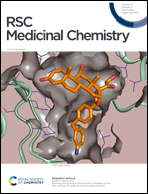Design, synthesis and biological evaluation of rhein–piperazine–furanone hybrids as potential anticancer agents†
Abstract
Novel rhein–piperazine–furanone hybrids, 5, were designed and synthesized efficiently from rhein. Cytotoxicity of all hybrids 5a–j against A549 human lung cancer cells was superior to the parent rhein and the reference cytarabine (CAR). Hybrid 5e (IC50 = 5.74 μM), the most potent compound, was 46- and 35-fold more toxic against A549 cells than rhein (IC50 = 265.59 μM) and CAR (IC50 = 202.57 μM), respectively. Moreover, hybrid 5e (IC50 = 69.28 μM) was less toxic to normal WI-38 human lung fibroblast cells with good selectivity (WI-38/A549, SI ≈ 12), being much higher than rhein (SI ≈ 1) and CAR (SI ≈ 2). Structure–activity relationship (SAR) analysis showed that cytotoxicity and selectivity against A549 lung cancer cells were greatly enhanced when methoxy-containing furanone was introduced to the hybrids (5e and 5h). Further, hybrid 5e showed better cytotoxicity against four types of human lung cancer cells (H460, A549, PC-9, and Calu-1; IC50 = 4.35–15.39 μM) than six other types of human cancer cells (SK-BR-3, SK-OV-3, 786-O, Huh-7, HCT116, and HeLa; IC50 = 13.77–60.45 μM), showing specificity. In particular, hybrid 5e showed the highest cytotoxicity (IC50 = 4.35 μM) and the highest selectivity (WI-38/H460, SI ≈ 16) against H460 human lung cancer cells. Flow cytometric analysis showed that hybrid 5e induced apoptosis in a concentration-dependent manner in H460 cells. The results show that the cytotoxicity and selectivity of rhein can be greatly enhanced by hybridization with furanone. Hybrid 5e is expected to be a leading candidate for anti-lung cancer drugs.



 Please wait while we load your content...
Please wait while we load your content...